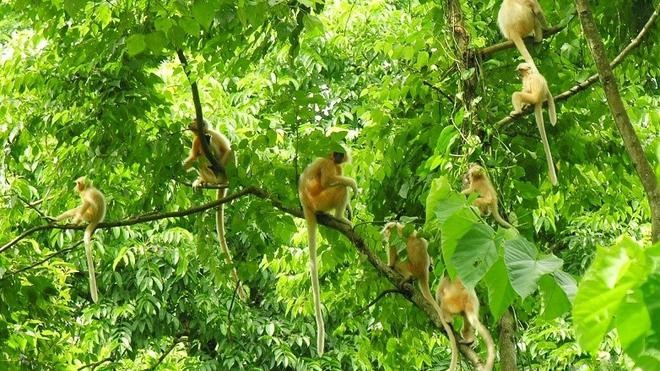
Golden langur

11.03.2024
Golden langur , Daily Current Affairs , RACE IAS : Best IAS Coaching in Lucknow
|
For Prelims:About the Survey,Important points,About Golden Langur,Geographical range of the Golden Langur,Natural habitat of Golden Langur,conservation status |
Why in the news?
Recently the population of the golden langur in India has been estimated at 7,396.
Important points:
- This population estimation was also conducted under the supervision of Dr. Biswas.
- The previous population estimate in 2008-09, also conducted under the supervision of Dr. Biswas, recorded 6,000 golden langurs in India.
- Each group then contained an average of 9.24 persons, which was 1.45 persons less than the average group recorded in the latest survey.
About the Survey:
- A comprehensive population estimate of the endangered primate was conducted in two phases by the Primate Research Center NE India (PRCNE), Assam Forest Department, Bodoland Territorial Council, Salim Ali Center for Ornithology and Natural History (SACON), and Conservation Himalaya.
- The results of the survey were completed in the month of February-March 2024
- In the first phase during March–April 2020, the survey covered the western part of the Manas Biosphere Reserve, including the Ripu Reserve Forest.
- The second phase in March-April 2021 focused on fragmented forest habitats of golden langurs in Bongaigaon, Kokrajhar and Dhubri districts of western Assam.
- Primate species are present only in these areas in the country.
- The block count method was applied for the first time to estimate the abundance, spatial distribution and density of the golden langur population.
- This method is considered relatively simple, cost-effective and robust for small group-dwelling primates such as arboreal and golden langurs.
- The golden langur habitat was divided into 51 counting blocks, each covered with 50-hectare grid cells.
- Estimating the minimum population size, the survey found that there were 7,396 golden langurs in 707 groups, including bisexual and male bands, as well as 31 solitary male langurs.
- The population of golden langurs is divided into two major sub-populations.
- The northern extended population, which covers the western part of the Manas Biosphere Reserve, extends from the Sankosh River to the Manas River along the northern edge of National Highway 27 and State Highway 2 to the India-Bhutan border.
- The southern fragmented population is found from the southern bank of NH27 to the Brahmaputra River in the south.
- The northern population of the golden-shinned primate was estimated to be 5,566 individuals in 534 groups and 23 solitary males.
- The population of southern baboons was estimated to be 1,830 baboons in 173 groups and eight solitary males.
- Ripu Reserve Forest was home to the largest (2,847) population of northern golden langurs.
- Chakrashila Wildlife Sanctuary in Kokrajhar district contained 838 individuals, the highest in the primate's southern fragmented range.
About Golden Langur (Trachypithecus giei):
- Golden langurs are most easily identified by the color of their fur, after which they are named.
- Their fur changes color according to the season.
- The color of babies also differs from that of adults as they are almost pure white.
Geographical range of the Golden Langur:
- It is restricted to Assam, India and neighboring Bhutan where they live throughout the year.
- The area in which they live is limited to an area bounded by four geographical points: the foothills of Bhutan (north), the Manas River (east), the Sankosh River (west), and the Brahmaputra River (south).
Natural habitat of Golden Langur:
- They occupy moist evergreen and tropical deciduous forests as well as some riverine areas and savannas in Assam and Bhutan.
- They are heavily dependent on trees, living in the upper canopy of subtropical forests in the south and more temperate forests in the north.
conservation status :
- It has been placed in the endangered category of IUCN.
- In Appendix I of the quotation
- It is included in Schedule I of the Wildlife Protection Act, 1972.
Source: The Hindu